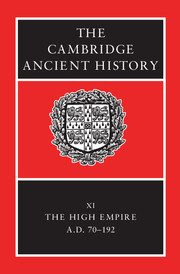Book contents
- Frontmatter
- PART I NARRATIVE
- PART II GOVERNMENT AND CIVIL ADMINISTRATION
- PART III THE EMPIRE
- PART IV ROME, ITALY AND THE PROVINCES
- 12 Rome and Italy
- 13 Spain
- 14 Gaul
- 15 Roman Germany
- 16 Africa
- 17 Cyrenaica
- 18 Britain
- 19 The Danube provinces
- 20 Greece and Asia Minor
- 21 Syria and Arabia
- 22 Judaea
- PART Va ECONOMY AND SOCIETY
- PART Vb ART AND CULTURE
- Chronological Table
- BIBLIOGRAPHY
- Index
- 1 The Roman world in the time of Marcus Aurelius
- 7 The Danube provinces
- References
19 - The Danube provinces
from PART IV - ROME, ITALY AND THE PROVINCES
Published online by Cambridge University Press: 28 March 2008
- Frontmatter
- PART I NARRATIVE
- PART II GOVERNMENT AND CIVIL ADMINISTRATION
- PART III THE EMPIRE
- PART IV ROME, ITALY AND THE PROVINCES
- 12 Rome and Italy
- 13 Spain
- 14 Gaul
- 15 Roman Germany
- 16 Africa
- 17 Cyrenaica
- 18 Britain
- 19 The Danube provinces
- 20 Greece and Asia Minor
- 21 Syria and Arabia
- 22 Judaea
- PART Va ECONOMY AND SOCIETY
- PART Vb ART AND CULTURE
- Chronological Table
- BIBLIOGRAPHY
- Index
- 1 The Roman world in the time of Marcus Aurelius
- 7 The Danube provinces
- References
Summary
The long interval between the two civil-war triumphs of the Danube legions, in 69 for the Flavians and in 193 for the Severi, witnessed a steady but unremarkable assimilation of the Celtic, Illyrian and Thracian peoples of the Danube lands to a Latin-speaking Roman provincial culture. On the south a limit was set to this process by the Hellenistic traditions of the ancient kingdoms of Epirus, Macedonia and Thrace. Their northern boundaries defined the linguistic frontier of the Roman world between the Latin West and the Greek East. The Danube provinces of the Roman empire were dominated by the presence of the army. By around the end of the period almost half of the legions (twelve out of thirty; c. 60,000 men) and more than a third of the auxilia (c. 80,000 men) were based along the Danube. The legions which had advanced the boundaries of the empire to the Danube in the first century a.d. came from Italy and the colonies. They demanded their rewards from the Caesar, cash payments or acceptable allotments of land in specially founded colonies. That state of affairs persisted until the reign of Hadrian (117–38), when the role of the army became essentially static, upholding the status quo while maintaining a peacetime efficiency through training and manoeuvres. The provincial armies now became rooted in the lands where they were stationed, tied through a cycle of recruitment and discharge to the communities which had grown up in the vicinity of the frontiers. Three generations after the reign of Hadrian saw the Illyriciani of the Danube lands a dominant group in the power struggles of the empire.
Keywords
- Type
- Chapter
- Information
- The Cambridge Ancient History , pp. 577 - 603Publisher: Cambridge University PressPrint publication year: 2000
References
- 7
- Cited by

